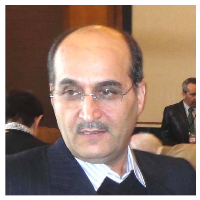Analysis of the Effect of Tectonics and Erosion on the Evolution of Northwestern Zagros Landscapes Using Topographic Swath Profiles
Interaction between tectonic and surface processes to create and dissect topography is the main area of emphasis in tectonic geomorphology (Burbank & Anderson, 2001: 2). Growing usage of GIS and DEMs have improved techniques of landscape analysis in Tectonic geomorphology. One of the widely used approaches in tectonic geomorphology to recognize general elements on landscape related to tectonic is analyzing topographic patterns by swath profiles (Perez Pena et al, 2017: 136). To avoid arbitrariness of selecting a single profile line, earth scientists use topographic swath profiles (Telbisz et all, 2013: 485). Examining elevation values associated with corresponding coordinates is one of the most common variables to study by swath profiles (Telbisz et all, 2013: 487، Yousefi Bavil & Yousefi Bavil, 2019: 281). In these projected profiles, contours and equally spaced profile lines intersections are determined inside a band (Grohman, 2004: 1059). In the present study, in order to evaluate the long-term equilibrium of northwestern Zagros landscapes in response to internal and external forces that uplift or tear down its topography, Perez-Pena et al (2017) method of extracting swath profiles has been used. We have also used their new transverse hypsometry index for analyzing hypsometry along the swath. Since different parts of the Zagros are subjected to different tectonic force vectors, thereby, the rate of tectonic processes and the resultant forms are not the same. On the other hand, surface processes make these landscapes’ evolution more complex. To simplify the topographic pattern of these complex processes, 10 swath profiles parallel and perpendicular to the Lorestan arc and its adjacent crushed zone trend have been plotted and interpreted.
Topographic swath profiles are created by projecting topographic profiles with equal space inside a strip or swath (Perez-Pena et all, 2017; Fielding et al., 1994). This method is applied for sampling and analyzing a value and its changes for representing three-dimensional datasets on a two-dimensional diagram that is more systematic than ordinary profiles with arbitrary cross-profiles (Yousefi Bavil & Yousefi Bavil , 2019; Telbisz, et all. 2013; Hergarten, et al, 2014).In the swath profile, statistical parameters of elevation values (maximum, minimum, mean, quartile 1 and 3 as well as local relief) can be calculated and plotted against the distance (Telbisz et all, 2013: 485). Different methods of constructing swath profiles have been explained by Telbisz et al, 2013; Hergarten et al, 2014, Perez Pena et al, 2017, Yousefi Bavil and Yousefi Bavil, 2019. In this article, Perez Pena et al (2017) approach has been used to extract swath profiles which allows constructing swath profiles for curved features. This kind of swath profile is made up of calculating parallel lines to the baseline and sampling their length with defined step sizes. In addition, considering the deviations of mean elevation to the maximum or minimum elevations, by re-scaling hypsometric integral values in a defined range (between 0.2 and 0.8), an enhanced transverse hypsometry index (or THi*) can provide better comparison of hypsometry along swath profile. All these commands can be implemented in GIS software by swath profiler add-in programmed by Perez-Pena et al (2017). Here digital elevation model is the elevation source and a line or curved feature is the baseline. The step size and total width of profiles also can be changed in the input box of the add-in. In this study, swath profiles with 40 meters step size inside a strip with a width of 20 km (10 meters from each side of baseline or main profile line) for five transects perpendicular to Zagros trend (NE-SW) named P1 to P5 and five transects parallel to its trend (NW-SE) named H1 to H5 (fig. 8) along with their main fault have been extracted (fig. 9 & 10). The NW-SE baselines follow the main Zagros faults (Berberian, 1995) in area (Zagros main reverse fault and Zagros recent fault, high Zagros fault, Zagros mountain front fault, and Zagros foredeep fault). Five NW-SE curve lines cross morphotectonic units of Zagros (Berberian, 1995) which are adjacent (High Zagros thrust belt, Zagros simply folded belt, and Zagros foredeep contains Dezful and Kirkuk embayments).
In plotted swath profiles, mean elevation represents general topographic trend of landscape within swath; minimum and maximum elevation show landscape variation perpendicular to the swath, local relief, and quartile describe topographic variation along the swath. Upward deflection of mean elevation to maximum elevation reveals a transite state of landscape adjustment to high uplift rates. Stable state landscapes including basins and plateaus with low incision rates have smoother local relief curve where the swath curves are merged (Perez-Pena et al, 2017: 137). Based on the exported diagrams, higher values of enhanced transverse hypsometry index (Thi*) occurs when the third quartile and in some points mean elevation is closer to the maximum. When swath curves meet the flat areas of Zagros foredeep (Dezful embayment) merging together, Thi* values keep a constant value of about 0.5.
Results show that in swath profiles with the direction perpendicular to the Zagros trend, comparing areas with different uplift and incision is better possible. In both perpendicular and parallel swath profiles, high values of the enhanced transverse hypsometry integral (THi*) introduce a young relief that is being incised by a drainage network with steep valleys. These high values of THi* can be observed in the location of anticlines of Zagros simply folded belt unit and as well as in intersections of main faults with swath profiles in most swath diagrams. High local relief and wider variation of curves in most swath profiles, except the end parts of the southwest of the region, can characterize a dissected landscape exposed to high incision or uplift.
Erosion , Northwestern Zagros , Relief , Swath , Tectonic
- حق عضویت دریافتی صرف حمایت از نشریات عضو و نگهداری، تکمیل و توسعه مگیران میشود.
- پرداخت حق اشتراک و دانلود مقالات اجازه بازنشر آن در سایر رسانههای چاپی و دیجیتال را به کاربر نمیدهد.



